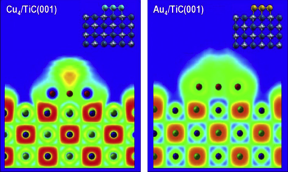CO2 Hydrogenation on Au/TiC, Cu/TiC, and Ni/TiC Catalytst: Production of CO, Methanol, and Methane.
CO2 Hydrogenation on Au/TiC, Cu/TiC, and Ni/TiC Catalytst: Production of CO, Methanol, and Methane.
J.A. Rodriguez, J. Evans, L. Feria, A.B. Vidal, P. Liu, K. Nakamura, F. Illas
J. Catal., 307 (2013) 162.

Electron-polarization plots for Cu4 (left) and Au4 (right) supported on TiC(001)
Small Au, Cu, and Ni particles in contact with TiC(001) display a very high activity for the catalytic hydrogenation of CO2. The major product over these catalysts is CO which is produced by the reverse water–gas shift reaction (RWGS, CO2 + H2 → CO + H2O). In the cases of Au/TiC(001) and Cu/TiC(001), a substantial amount of methanol is also produced, but no methane is detected. Ni/TiC(001) produces a mixture of CO, methanol, and methane. The highest catalytic activity is found for small two-dimensional particles or clusters of the admetals in close contact with TiC(001). The catalytic activity of the supported metals can be orders of magnitude higher than those of Au(100), Cu(100), or Ni(100). Density functional calculations point to HOCO as a key intermediate for the generation of CO through the RWGS, with the production of methanol probably involving the hydrogenation of a HCOO intermediate or the CO generated by the RWGS.
